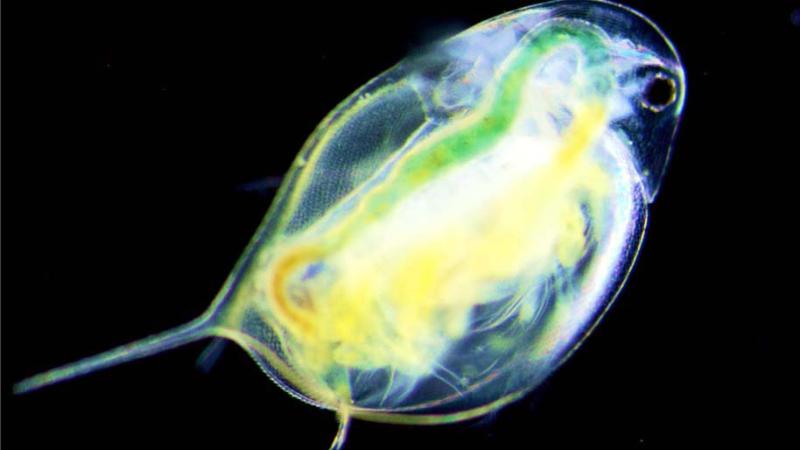Findings indicate that ecosystems may possess some resilience amid rising use of deicing salts
January 6, 2017

A common species of zooplankton—the smallest animals in the freshwater food web—can evolve genetic tolerance to moderate levels of road salt in as little as two and a half months, according to new research published online today in the journal Environmental Pollution. The study is the first to demonstrate that the animals can rapidly evolve higher tolerance to road salt, and indicates that freshwater ecosystems may possess some resilience in the face of a 50-fold increase in road deicing salt applications since the 1940s.
“These animals evolved tolerance in just two and a half months. That’s a really short time period, far faster than we often think of evolution happening,” said Rick Relyea, lead researcher and a professor of biological sciences at Rensselaer Polytechnic Institute. “The hopeful message here is that, to some degree, zooplankton can evolve a higher tolerance to salt than is found in pristine wetlands and lakes and, in turn, help protect these ecosystems from the impacts of salt.”
The research is part of the Jefferson Project at Lake George—a collaboration between Rensselaer, IBM Research, and The FUND for Lake George—founded to develop a new model for technologically enabled environmental monitoring and prediction to understand and protect the Lake George ecosystem and freshwater ecosystems around the world. Relyea is director of the Jefferson Project and the David M. Darrin ’40 Senior Endowed Chair at Rensselaer.
The use of deicing road salts has increased from .28 million metric tons per year in the 1940s to over 16 million metric tons per year today. As part of the Jefferson Project, the Relyea lab is conducting a suite of experiments to test the effects of road salt on ecosystems. Recent research was reported in an article in the Canadian Journal of Fisheries and Aquatic Sciences, which found that high levels of road salt can alter the sex ratios of frogs; an article in Environmental Toxicology and Chemistry, which documented the effects of road salt and a common insecticide on wetland food webs; and an article in Environmental Pollution, which examined potential interactions between road salt, predators, and competitors in wetland food webs.
In the newly published work, researchers tested whether a common species of zooplankton, Daphnia pulex, could evolve increased tolerance to road salt. Daphnia pulex is vital to freshwater ecosystems. It is a major consumer of algae and a preferred food source for many fish species. Water quality suffers in ecosystems where Daphnia populations have declined, and the loss of Daphnia can have cascading effects through the food web. For example, a lack of healthy zooplankton populations can trigger harmful algal blooms.
Using 1,200-liter tanks outfitted to mimic lake ecosystems, researchers exposed Daphnia to five levels of road salt (sodium chloride) ranging from a relatively low concentration of 15 milligrams chloride per liter (the current Lake George concentration) to a high concentration of 1,000 milligrams per liter (mimicking highly contaminated lakes in North America). After two and a half months, about five to 10 generations in Daphnia, the researchers collected the Daphnia from each tank and raised their progeny for three generations under low salt concentrations.
Researchers then studied how well the descendants of the different populations fared when subsequently exposed to road salt, from 30 to 1,900 milligrams per liter, for 48 hours. At the intermediate salt concentrations, populations previously exposed to elevated concentrations of salt had higher rates of survival than populations previously exposed to natural concentrations of salt. For example, when exposed to 1,300 milligrams per liter, descendants of Daphnia previously exposed to 250 milligrams per liter experienced 92 percent survival whereas descendants of Daphnia previously exposed to 15 milligrams per liter experienced only 46 percent survival.
“At the highest concentrations of salt, none of the zooplankton survived. But under moderate concentrations, much higher than those found in Lake George, these zooplankton evolved higher tolerance,” said Relyea. “This is the first study to demonstrate that zooplankton can evolve increased tolerance to road salt, and the results were quite unexpected.”
In follow-up research, the Relyea lab is testing whether Daphnia with evolved tolerance to road salt protect the food web against future road salt contamination. The team is also examining how evolved tolerance affects other aspects of Daphnia, such as their growth, reproduction, or life span.
The article, “Rapid evolution of tolerance to road salt in zooplankton,” by Kayla D. Coldsnow et. al. (doi: 10.1016/j.envpol.2016.12.024) appears in Environmental Pollution (2017), published by Elsevier. Authors also included Brian M. Mattes and William D. Hintz.
At Rensselaer, this research fulfills the vision of The New Polytechnic, an emerging paradigm for higher education which recognizes that global challenges and opportunities are so complex, they cannot be addressed by even the most talented person working alone. Rensselaer serves as a crossroads for collaboration — working with partners across disciplines, sectors, and geographic regions, to address global challenges — and addresses some of the world’s most pressing technological challenges, from energy security and sustainable development to biotechnology and human health. The New Polytechnic is transformative in the global impact of research, in its innovative pedagogy, and in the lives of students at Rensselaer.
About Rensselaer Polytechnic Institute
Rensselaer Polytechnic Institute, founded in 1824, is America’s first technological research university. For nearly 200 years, Rensselaer has been defining the scientific and technological advances of our world. Rensselaer faculty and alumni represent 84 members of the National Academy of Engineering, 17 members of the National Academy of Science, 25 members of the American Academy of Arts and Sciences, 8 members of the National Academy of Medicine, 7 members of the National Academy of Inventors, and 4 members of the National Inventors Hall of Fame, as well as a Nobel Prize winner in Physics. With 7,000 students and nearly 100,000 living alumni, Rensselaer is addressing the global challenges facing the 21st century—to change lives, to advance society, and to change the world. To learn more, go to www.rpi.edu.